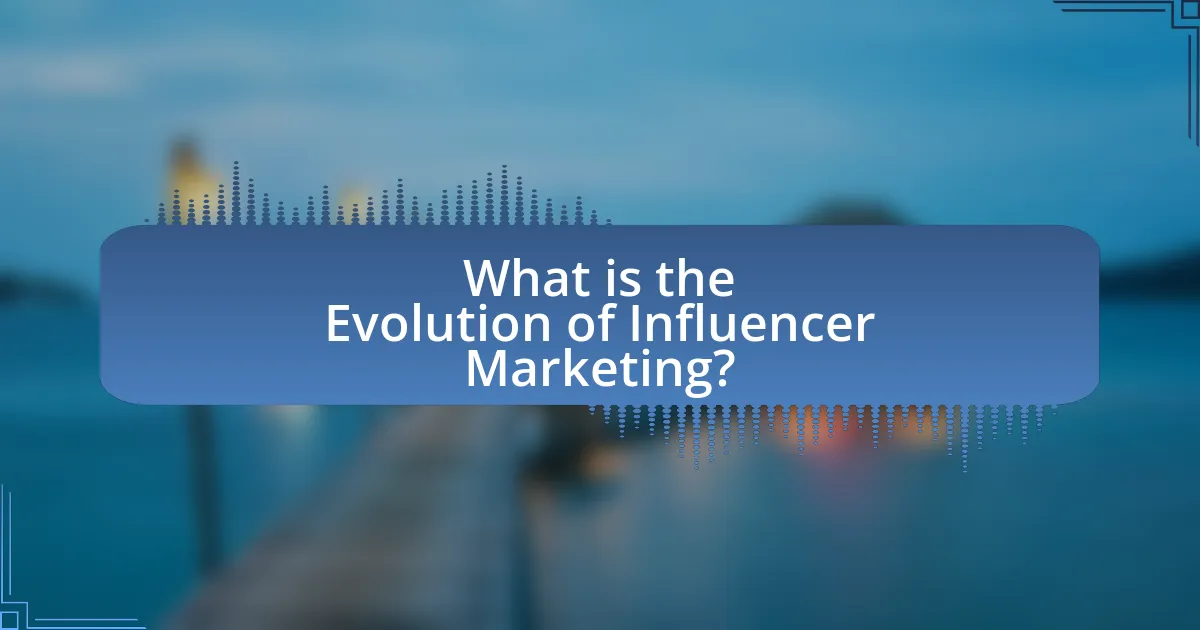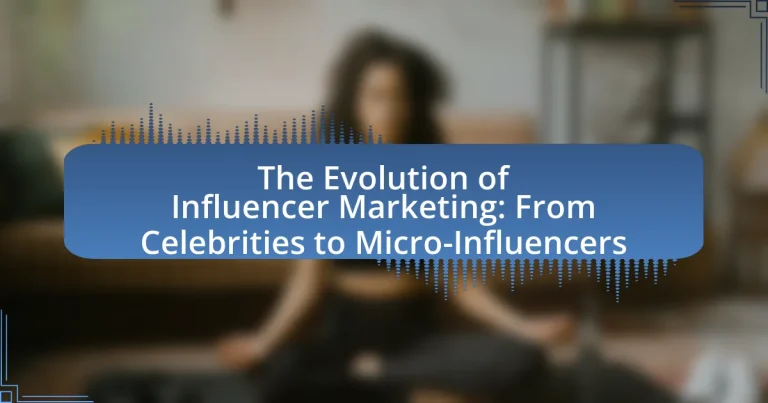The article examines the evolution of influencer marketing, tracing its development from traditional celebrity endorsements to the rise of micro-influencers. It highlights how social media has transformed marketing strategies, emphasizing the importance of authenticity and relatability in consumer engagement. Key topics include the effectiveness of micro-influencers compared to celebrities, the impact of technology and analytics on influencer campaigns, and the ethical considerations brands and influencers must navigate. Additionally, the article outlines best practices for successful collaborations and the trends shaping the future of influencer marketing.

What is the Evolution of Influencer Marketing?
The evolution of influencer marketing began with traditional celebrities endorsing products, which established the foundation for brand partnerships. In the early 2000s, the rise of social media platforms allowed everyday individuals to gain significant followings, leading to the emergence of micro-influencers who often have higher engagement rates than celebrities. Research by the Digital Marketing Institute indicates that 70% of millennials are influenced by the recommendations of their peers in purchasing decisions, highlighting the shift from celebrity endorsements to authentic connections with niche audiences. This transition reflects a broader trend where brands increasingly prioritize relatability and trust over sheer reach, adapting their strategies to leverage the unique advantages offered by micro-influencers.
How has influencer marketing changed over the years?
Influencer marketing has evolved significantly from its inception, transitioning from reliance on traditional celebrities to a focus on micro-influencers. Initially, brands primarily partnered with high-profile celebrities to reach broad audiences, but this approach often resulted in lower engagement rates. As social media platforms grew, the rise of micro-influencers—individuals with smaller, yet highly engaged followings—became evident. Research indicates that micro-influencers can achieve engagement rates up to 60% higher than those of macro-influencers, making them more effective for targeted marketing campaigns. This shift reflects a broader trend towards authenticity and relatability in marketing, as consumers increasingly prefer recommendations from individuals they perceive as genuine and trustworthy.
What were the early forms of influencer marketing?
The early forms of influencer marketing primarily involved celebrity endorsements and sponsorships. In the mid-20th century, brands began leveraging the popularity of movie stars, athletes, and musicians to promote their products, recognizing that these figures could sway public opinion and consumer behavior. For instance, in the 1950s, brands like Coca-Cola and Marlboro utilized famous personalities to enhance their brand image and reach wider audiences, establishing a precedent for future marketing strategies that relied on influential figures to drive sales and brand loyalty.
How did social media impact influencer marketing?
Social media significantly transformed influencer marketing by providing a platform for direct engagement between brands and consumers. This shift allowed brands to leverage the reach and authenticity of influencers, leading to increased trust and higher conversion rates. According to a 2021 survey by the Digital Marketing Institute, 49% of consumers depend on influencer recommendations when making purchasing decisions, highlighting the effectiveness of influencer marketing in the social media landscape. Additionally, the rise of micro-influencers, who often have smaller but more engaged audiences, has further diversified marketing strategies, enabling brands to target niche markets effectively.
Why is influencer marketing important today?
Influencer marketing is important today because it effectively leverages the trust and authenticity that influencers have built with their audiences. This marketing strategy allows brands to reach targeted demographics more efficiently, as influencers often have niche followings that align with specific consumer interests. According to a 2021 survey by HubSpot, 61% of consumers trust influencer recommendations, making them more likely to purchase products endorsed by these figures compared to traditional advertising methods. Additionally, the rise of social media platforms has amplified the reach and impact of influencer marketing, with the global influencer marketing industry projected to reach $13.8 billion in 2021, highlighting its growing significance in modern marketing strategies.
What role do influencers play in modern marketing strategies?
Influencers play a crucial role in modern marketing strategies by acting as trusted intermediaries between brands and consumers. They leverage their established credibility and audience engagement to promote products and services, often resulting in higher conversion rates compared to traditional advertising methods. For instance, a study by the Digital Marketing Institute found that 49% of consumers depend on influencer recommendations when making purchase decisions. This demonstrates that influencers effectively drive brand awareness and consumer trust, making them integral to contemporary marketing approaches.
How does influencer marketing compare to traditional advertising?
Influencer marketing is generally more effective than traditional advertising due to its ability to engage audiences authentically. Influencers often have established trust with their followers, leading to higher engagement rates; for instance, influencer marketing can yield engagement rates of 1% to 3%, while traditional ads typically see rates below 0.1%. Additionally, influencer marketing allows for targeted outreach to specific demographics, enhancing relevance and conversion rates. According to a study by the Digital Marketing Institute, 49% of consumers depend on influencer recommendations, compared to only 23% who trust traditional advertisements. This demonstrates that influencer marketing not only reaches audiences more effectively but also fosters a deeper connection, making it a preferred strategy in modern marketing.

Who are the key players in influencer marketing?
The key players in influencer marketing include brands, influencers, and social media platforms. Brands leverage influencers to reach target audiences, while influencers, ranging from celebrities to micro-influencers, create content that resonates with their followers. Social media platforms, such as Instagram, TikTok, and YouTube, serve as the primary channels for these interactions, facilitating engagement and content distribution. According to a 2021 report by Influencer Marketing Hub, the influencer marketing industry is projected to reach $13.8 billion in 2021, highlighting the significant role these players have in shaping marketing strategies.
What distinguishes celebrities from micro-influencers?
Celebrities are distinguished from micro-influencers primarily by their level of fame and audience size. Celebrities typically have millions of followers across various platforms and are widely recognized due to their work in entertainment, sports, or other high-profile industries. In contrast, micro-influencers usually have a smaller, more niche following, often ranging from 1,000 to 100,000 followers, and they tend to engage with their audience on a more personal level. This difference in audience size and engagement can lead to varying effectiveness in marketing campaigns, as studies show that micro-influencers often achieve higher engagement rates due to their perceived authenticity and relatability compared to celebrities.
How do celebrities influence consumer behavior?
Celebrities influence consumer behavior primarily through their ability to shape perceptions and create aspirational lifestyles. Their endorsements can significantly increase brand visibility and credibility, leading to higher consumer trust and purchase intentions. Research indicates that 49% of consumers rely on celebrity endorsements when making purchasing decisions, as these figures demonstrate the effectiveness of celebrity influence in marketing strategies. Additionally, the emotional connection fans feel towards celebrities can drive brand loyalty, as consumers often aspire to emulate the lifestyles of their favorite stars.
What advantages do micro-influencers offer brands?
Micro-influencers offer brands higher engagement rates and more authentic connections with their audiences. Research indicates that micro-influencers, defined as individuals with 1,000 to 100,000 followers, typically achieve engagement rates of 3.5% to 7%, compared to 1% to 3% for larger influencers. This heightened engagement stems from their niche audiences, which often trust their recommendations more due to perceived authenticity. Additionally, brands can benefit from lower costs when partnering with micro-influencers, as they generally charge less than macro-influencers or celebrities, making influencer marketing more accessible for smaller brands.
How do brands choose the right influencers?
Brands choose the right influencers by assessing alignment with their target audience, brand values, and campaign goals. This involves analyzing the influencer’s engagement rates, audience demographics, and content style to ensure compatibility. For instance, a study by Influencer Marketing Hub found that 63% of marketers prioritize engagement over follower count when selecting influencers, indicating that authentic connections with the audience are crucial. Additionally, brands often utilize tools like social media analytics to evaluate potential influencers’ performance metrics, ensuring they select individuals who can effectively amplify their message and drive desired outcomes.
What criteria should brands consider when selecting influencers?
Brands should consider the influencer’s audience demographics, engagement rates, content relevance, authenticity, and alignment with brand values when selecting influencers. Audience demographics ensure that the influencer’s followers match the target market, while engagement rates indicate how actively the audience interacts with the influencer’s content. Content relevance ensures that the influencer’s niche aligns with the brand’s products or services, enhancing the effectiveness of the partnership. Authenticity is crucial, as influencers with genuine connections to their audience tend to drive higher trust and conversion rates. Lastly, alignment with brand values ensures that the influencer’s image and messaging resonate with the brand’s identity, fostering a cohesive marketing strategy.
How can brands measure the effectiveness of influencer partnerships?
Brands can measure the effectiveness of influencer partnerships through key performance indicators (KPIs) such as engagement rates, reach, and conversion metrics. Engagement rates, which include likes, comments, and shares, provide insight into how well the audience interacts with the content. Reach indicates the total number of unique users who see the influencer’s posts, helping brands understand the potential audience size. Conversion metrics, such as click-through rates and sales generated from specific campaigns, offer concrete data on the financial impact of the partnership. According to a 2021 study by Influencer Marketing Hub, 63% of marketers reported that measuring ROI from influencer marketing is a top priority, highlighting the importance of these metrics in evaluating partnership success.

What are the trends shaping the future of influencer marketing?
The trends shaping the future of influencer marketing include the rise of micro and nano influencers, increased focus on authenticity, and the integration of artificial intelligence in campaign strategies. Micro and nano influencers, who typically have smaller but highly engaged audiences, are becoming preferred choices for brands due to their perceived authenticity and relatability, which can lead to higher engagement rates. A study by the Digital Marketing Institute found that micro influencers can generate up to 60% higher engagement than their macro counterparts. Additionally, brands are increasingly prioritizing authentic content that resonates with audiences, moving away from overly polished advertisements. The use of artificial intelligence is also transforming influencer marketing by enabling brands to analyze data more effectively, identify suitable influencers, and optimize campaign performance. According to a report by Influencer Marketing Hub, 67% of marketers believe AI will significantly impact influencer marketing strategies in the coming years.
How is technology influencing influencer marketing strategies?
Technology is significantly influencing influencer marketing strategies by enabling data-driven decision-making and enhancing audience targeting. Advanced analytics tools allow brands to assess influencer performance metrics, such as engagement rates and audience demographics, leading to more effective partnerships. For instance, a study by Influencer Marketing Hub in 2021 revealed that 63% of marketers use analytics to measure the success of their influencer campaigns, demonstrating the reliance on technology for optimizing marketing efforts. Additionally, social media platforms have integrated features that facilitate direct collaboration between brands and influencers, streamlining the campaign process and increasing efficiency.
What role do analytics play in influencer marketing?
Analytics play a crucial role in influencer marketing by providing data-driven insights that enhance campaign effectiveness. These insights allow brands to evaluate influencer performance, audience engagement, and return on investment (ROI). For instance, analytics tools can track metrics such as reach, impressions, and conversion rates, enabling marketers to identify which influencers yield the best results. According to a study by Influencer Marketing Hub, 63% of marketers believe that measuring ROI is the most important aspect of influencer marketing, highlighting the necessity of analytics in optimizing strategies and ensuring successful collaborations.
How are emerging platforms changing the influencer landscape?
Emerging platforms are transforming the influencer landscape by enabling niche content creation and fostering direct engagement between influencers and their audiences. These platforms, such as TikTok and Clubhouse, prioritize short-form and interactive content, allowing micro-influencers to gain visibility and build communities around specific interests. For instance, TikTok’s algorithm promotes content based on user engagement rather than follower count, which democratizes visibility and allows smaller influencers to reach wider audiences. This shift is evidenced by the rise of micro-influencers, who, according to a 2021 study by Influencer Marketing Hub, achieve higher engagement rates than traditional celebrities, with an average engagement rate of 3.86% compared to 1.21% for larger influencers.
What ethical considerations are involved in influencer marketing?
Ethical considerations in influencer marketing include transparency, authenticity, and the potential for misleading audiences. Influencers must disclose paid partnerships to ensure that their followers are aware of commercial relationships, as mandated by the Federal Trade Commission (FTC) guidelines. This transparency helps maintain trust between influencers and their audiences. Additionally, influencers should promote products that align with their personal values and the interests of their followers to avoid misleading endorsements. Research indicates that 61% of consumers are more likely to trust influencers who are transparent about their sponsorships, highlighting the importance of ethical practices in maintaining credibility and consumer trust.
How can influencers maintain authenticity with their audience?
Influencers can maintain authenticity with their audience by consistently sharing genuine experiences and opinions that align with their personal values. This approach fosters trust, as audiences are more likely to connect with influencers who present themselves honestly and transparently. Research indicates that 86% of consumers consider authenticity an important factor when deciding which brands to support, highlighting the significance of genuine content in influencer marketing. By prioritizing relatable storytelling and engaging in two-way communication with followers, influencers can further enhance their credibility and strengthen their relationship with their audience.
What regulations should brands and influencers be aware of?
Brands and influencers should be aware of the Federal Trade Commission (FTC) guidelines regarding endorsements and testimonials. These regulations require that any material connection between influencers and brands be disclosed to ensure transparency and honesty in advertising. For instance, influencers must clearly indicate when they are being compensated for promoting a product, using hashtags like #ad or #sponsored. Failure to comply with these regulations can result in legal action and penalties, as evidenced by the FTC’s enforcement actions against influencers and brands for misleading advertising practices.
What best practices should brands follow in influencer marketing?
Brands should prioritize authenticity, audience alignment, and measurable outcomes in influencer marketing. Authenticity ensures that influencers genuinely connect with their audience, which enhances trust and engagement; studies show that 92% of consumers trust recommendations from individuals over brands. Audience alignment involves selecting influencers whose followers match the brand’s target demographic, maximizing relevance and impact. Lastly, measurable outcomes, such as tracking engagement rates and conversions, allow brands to assess the effectiveness of their campaigns, with 70% of marketers indicating that measuring ROI is crucial for future strategies. By adhering to these best practices, brands can optimize their influencer marketing efforts effectively.
How can brands effectively collaborate with influencers?
Brands can effectively collaborate with influencers by establishing clear objectives, selecting the right influencers, and fostering authentic relationships. Setting specific goals, such as increasing brand awareness or driving sales, helps guide the collaboration. Choosing influencers whose audience aligns with the brand’s target demographic ensures relevance; for instance, a study by Influencer Marketing Hub found that 63% of marketers believe that influencer marketing is effective for reaching specific audiences. Building genuine relationships through open communication and mutual respect enhances trust, leading to more impactful campaigns.
What strategies can enhance the success of influencer campaigns?
To enhance the success of influencer campaigns, brands should focus on selecting the right influencers whose audience aligns with their target market. Research indicates that 49% of consumers depend on influencer recommendations for their purchasing decisions, highlighting the importance of relevance in influencer selection. Additionally, establishing clear goals and measurable KPIs allows brands to track campaign effectiveness, with 70% of marketers reporting that setting specific objectives improves campaign outcomes. Engaging influencers in the creative process fosters authenticity, as campaigns that allow influencers to express their unique voice can lead to a 37% higher engagement rate. Finally, leveraging multiple platforms increases reach, as 83% of marketers believe that cross-channel strategies enhance overall campaign performance.


